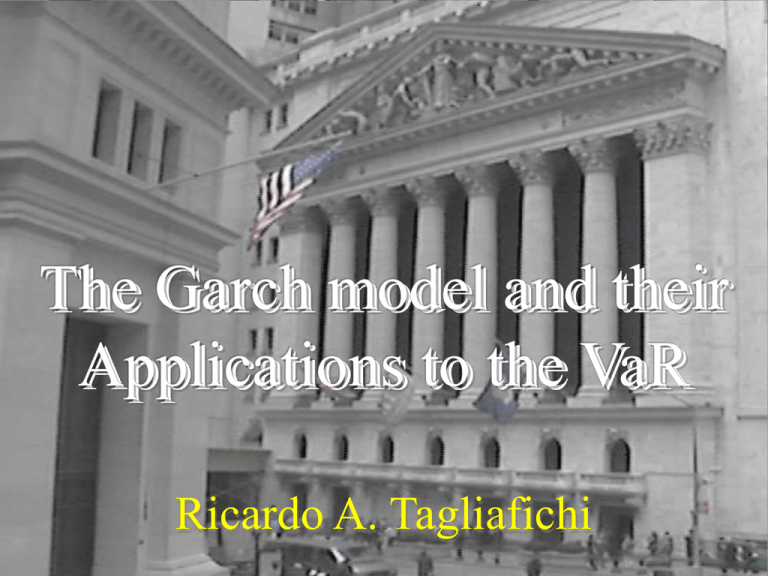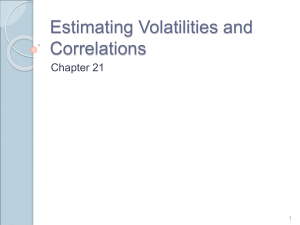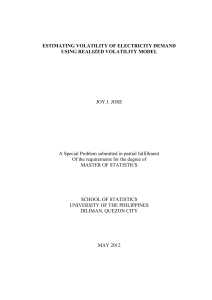The Garch model and their Applications to the VaR Ricardo A. Tagliafichi
advertisement

The Garch model and their Applications to the VaR Ricardo A. Tagliafichi The presence of the volatility in the assets returns Selection of a Portfolio with models as CAPM or APT The estimation of Value at Risk of a Portfolio The estimations of derivatives primes The classic hypothesis The capital markets are perfect, and has rates in a continuous form defined by: Rt=Ln(Pt)-Ln(Pt-1) These returns are distributed identically and applying the Central Theorem of Limits the returns are n.i.d These returns Rt, Rt-1, Rt-2, Rt-2,........, Rt-n,doesn't have any relationship among them, for this reason there is a presence of a Random Walk The great questions as a result of the perfect markets and the random walk rs = 0 sn = st (n/t) 0.5 The periodic structure of the volatility Merval Index n ln( s n ) ln( s 1 ) x ln( n) 2 0.54742 4 0.51488 8 0.52297 0,06 16 0.53161 0,04 32 0.52719 0,02 64 0.51825 128 0.51785 256 0.52206 Difference between s n s1 n and sn s1 n 0,08 0 2 4 8 16 32 64 128 256 x The memory of a process: The Hurst exponent Is a number related with the probability that an event is autocorrelated (R / S )n c n H Ln( R / S ) n Ln(c) H Ln(n) The meaning of H 0.50 < H < 1 imply that the series is persistent, and a series is persistent when is characterized by a long memory of its process 0 < H < 0.50 mean that the series is antipersistent. The series reverses itself more often than a random series series would The coefficient R/Sn The construction of these coefficient doesn’t require any gaussian process, neither it requires any parametric process The series is separated in a small periods, like beginning with a 10 periods, inside the total series, until arriving to periods that are as maximum half of the data analyzed We call n the data analyzed in each sub period and Rn= max(Yt..Yn) - min (Yt..Yn) and . R/Sn = average of Rn/average of Sn where Sn is the volatility of this sub period Some results of the coefficient H Index Dow Jones 4 Coeff. H 0.628 S.E. of H 0.011 R square 0.974 d Ln (R/S)n 3 2 1 0 2 3 4 5 Ln (n) 6 7 Const. -0.617 Some results of the coefficient H Indice Merval Coeff. H 0.589 S.E. of H 0.006 R square 0.987 d 5 Ln (R/S)n 4 3 2 1 2 3 4 5 Ln (n) 6 7 8 Const. -0.184 The conclusions of the use of H The series presents coefficients H over 0.50, that indicates the presence of persistence in the series Using the properties of R/Sn coefficient we can observe the presence of cycles proved by the use of the FFT and its significant tests. It is tempting to use de Hurst exponent to estimate de variance in annual terms, like the following: H s n s1 n The market performance Period Bono Merval Siderca Pro 2 90-94 95-00 90-94 95-00 95-00 Obs. 1222 Mean 0.109 0.015 0.199 0.057 0.0511 -0.022 Volatility 3.566 2.322 4.314 3.107 Skewness 0.739 -0.383 0.823 -0.32 -0.146 -0.559 Kurtosis 7.053 8.020 7.204 7.216 33.931 21.971 Assets 1500 1222 1500 1371 1.295 Maximum 24.40 12.08 26.02 17.98 14.46 Global 2027 99-00 504 1.1694 9.39 Minimum -13.52 -14.76 -18.23 -21.3 -11.78 -9.946 The market performance .. are the returns n.i.d.? The K-S test: P (Dn<en,0.99)= 0.95 is used to prove that the series has n.i.d. shows the following results: Asset Number of Observations Dn en,0.95 Merval Index 2722 0.0844 0.023534 Siderca 2722 0.0658 0.026534 Bono Pro2 1371 0.2179 0.036678 Bono Global 504 0.2266 0.060376 The independence of returns The autocorrelation function is the relationship between the stock’s returns at different lags. The Ljung Box or Q-statistic at lag 10: 10 Q n(n 2) i 1 r 2 i ni 2 10 The test of hypothesis Ho: r0 .... r10 0 H1: some r1 ....rk 0 Hurst coefficient and Ljung Box Q-Statistic Series Dow Jones Hurst Q – Statistic Coefficient for k = 10 33.205 0.628 Merval 52.999 0.589 Siderca 51.157 0.787 Pro 2 in dollars 46.384 0.782 Different crisis supported until government's change and the obtaining of the blinder from the MFI Effect convertibility Graph 1 - Daily returns Merval Index 30,0 25,0 20,0 15,0 10,0 5,0 0,0 -5,0 -10,0 -15,0 -20,0 08/31/2000 02/29/2000 09/02/1999 03/04/1999 09/10/1998 03/09/1998 09/16/1997 03/21/1997 10/01/1996 04/09/1996 10/13/1995 04/24/1995 11/01/1994 05/10/1994 11/17/1993 05/27/1993 12/01/1992 06/11/1992 12/16/1991 06/27/1991 12/28/1990 07/05/1990 01/10/1990 11/29/2000 06/30/2000 01/19/2000 08/18/1999 03/12/1999 10/13/1998 05/05/1998 12/01/1997 07/04/1997 02/03/1997 09/05/1996 04/03/1996 11/03/1995 06/07/1995 01/06/1995 08/09/1994 03/09/1994 10/12/1993 05/12/1993 12/10/1992 07/14/1992 02/11/1992 09/12/1991 04/12/1991 11/08/1990 06/08/1990 01/08/1990 Graphic 2 - Daily volatilities of Merval Index 30,000 25,000 20,000 15,000 10,000 5,000 0,000 Applying Fractal an statistical analysis we can say.... 1) The series of returns are not nid 2) Some rs 0 3) The st s1 t 0.5 4) There values of kurtosis and skewness in the series denote the presence of Heteroscedasticity The traditional econometrics assumed: The variance of the errors is a constant The owner of a bond or a stock should be interested in the prediction of a volatility during the period in that he will be a possessor of the asset The Arch model .... We can estimate the best model to predict a variable, like a regression model or an ARIMA model In each model we obtain a residual series like: e t Yt Yˆt Engle 1982 e e e . e 2 t 2 1 t 1 2 2 t 2 2 q t q ht ARCH (q) Autoregressive Conditional Heterocedastic Bollerslev 1986 q e ie 2 t i 1| p 2 t 1 jh j 1 2 t j GARCH (q,p) Generalized Autoregressive Conditioned Heteroskedastic vt A simple prediction of a volatility with Arch model s 1 ( Rt 1 R ) 2 t 2 Where: s2t = variance at day t Rt-1- R = deviation from the mean at day t-1 If we regress the series on a constant…. Rt c e t c = constant or a mean of the series et = deviation at time t ...if series et is a black noise then there is a presence of ARCH The ACF and the PAC of et 2 series The Ljung Box or Q-statistic at lag 10: MERVAL 01/90 11/94 12/94 12/00 359.48 479.52 SIDERCA GLOBAL 2017 01/90 11/94 12/94 12/00 11/98 12/00 477.93 392.65 151.35 How to model the volatility With the presence of a black noise and.... Analyzing the ACF and PACF using the same considerations for an ARMA process .... We can identify a model to predict the volatility Volatility of Merval Index modelling whith Garch (1,1) 16 14 12 10 8 6 4 10/13/2000 07/06/2000 03/21/2000 12/02/1999 08/25/1999 05/12/1999 02/01/1999 10/21/1998 07/08/1998 03/23/1998 12/11/1997 09/04/1997 05/26/1997 02/13/1997 11/05/1996 07/30/1996 04/18/1996 01/10/1996 09/28/1995 06/22/1995 03/10/1995 12/01/1994 2 0 The Garch (1,1) s e 2 t 2 1 t 1 1s 2 t 1 This model was used during 1990-1995 with a great success, previous to the “tequila effect” or Mexican crisis Some results of GARCH (1,1) applied to Merval Index 90-00 90-94 95-00 98-00 0.125 0.088 (0.0019) (0.030) 0.203 (0.035) 0.503 (0.138) 0.141 0.137 (0.0090) (0.018) 0.152 (0.012) 0.122 (0.020) 0.847 0.862 (0.0090) (0.016) 0.814 (0.015) 0.760 (0.040) 0.779 0.757 P(Q8) 0.516 0.774 The persistence of a Garch (1,1) The autoregressive root that governs the persistence of the shocks of the volatility is the sum of + Also + allows to predict the volatility for the future periods The persistence and the evolution of a shock on et in (t + t) days 1.2 1 0.8 0.6 0.4 0.2 0,986 0,975 0,95 0,9 23 21 19 17 15 13 11 9 7 5 3 1 0 0,8 With a Garch model, it is assumed that the variance of returns can be a predictable process If ... s e 2 t 2 1 t 1 1s 2 t 1 for the future t periods ... 1 ( ) s (t 1) ( ) 1 ( ) 1 ( ) t 1 2 1,t 1 ( ) 2 1 | ( ) s t t The news impact curve and the asymetric models After 1995, the impact of bad news in the assets prices, introduced the concept of the asymetric models, due to the effect of the great negative impact. The aim of these models is to predict the effect of the catastrophes or the impact of bad news The EGARCH (1,1) Nelson (1991) log( s ) log( s 2 t 2 t 1 e t 1 e t 1 ) s t 1 s t 1 This model differs from Garch (1,1) in this aspect: Allows the bad news (et and < 0) to have a bigger impact than the good news in the volatility prediction. The TARCH (1,1) Glosten Jaganathan and Runkle and Zakoian (1990) s s 2 t 2 t 1 e 2 t 1 d t 1 e 2 t 1 where d t 1 1 si e t 1 0 y d t 1 0 in other case is a positive estimator with weight when there are negative impacts NEWS IMPACT CURVE USING Garch and Asymetric Models 35 30 25 20 15 10 5 0 -10 Garch (1,1) -5 0 Tarch (1,1) 5 10 Egarch (1,1) The presence of asymetry. To detect the presence of asymetry we use the cross correlation function between the squared residuals of the model and the standarized residuals calculated as et/st Number of re(t),e(t-k) not null in the first –10 values Merval Index 01/90 11/94 12/94 12/00 11/99 12/00 0 5 4 What is Value at Risk? VaR measures the worst loss expected in a future time with a confidence level previously established VaR forecasts the amount of predictable losses for the next period with a certain probability Computing VaR VaR makes the sum of the worst loss of each asset over a horizon within an interval of confidence previously established “ .. Now we can know the risk of our portfolio, by asset and by the individual manage … “ The vice president of pension funds of Chrysler The steps to calculate VaR s market position t Volatility measure days to be forecasted VAR Level of confidence Report of potential loss The success of VaR Is a result of the method used to estimate the risk The certainty of the report depends from the type of model used to compute the volatility on which these forecast is based The EWMA to estimate the volatility EWMA, is used by Riskmetrics1 and this method established that the volatility is conditioned bay the past realizations k j 2 s t (1 ) s t ,t j j 1 1 Riskmetrics 2 is a trade mark of J.P.Morgan The EWMA and GARCH Using 0.94 for EWMA models like was established by the manuals of J. P. Morgan for all assets of the portfolio is the same as using a Garch (1,1) as follows: What happen after 1995 Today, the best model to compute the volatility of a global argentine bond is a Tarch(1,1) Limits for the estimation of VaR with Tarch(1,1) y Riskmetrics for Global Argentine Bond 1999-2000 15 10 5 0 -5 -10 -15 Conclusions Using the ACF and PACF in one hand and using fractal geometry in the other hand we arrive to the following expressions: rs 0 and sn st (n/t) 0.5 That allow the use of Garch models to forecast the volatility Conclusions With the right model of Garch we can forecast the volatility for different purposes in this case for the VaR There are different patterns between the returns previous 1995 (Mexican crisis) and after it Conclusions If volatility is corrected estimated the result will be a trustable report Each series have its own personality, each series have its own model to predict volatility In other words.. When bad news are reported resources are usefull, when good news are present resources are not needed The Future The use of derivatives for reducing de Var of a portfolio To calculate the primes of derivatives Garch models will be use Questions




